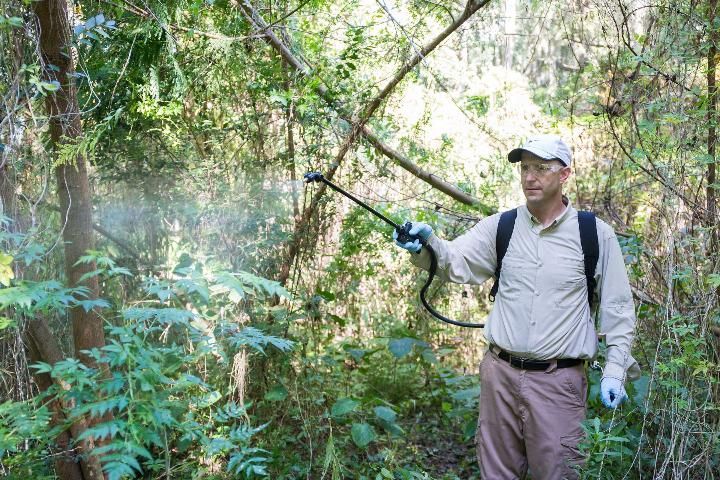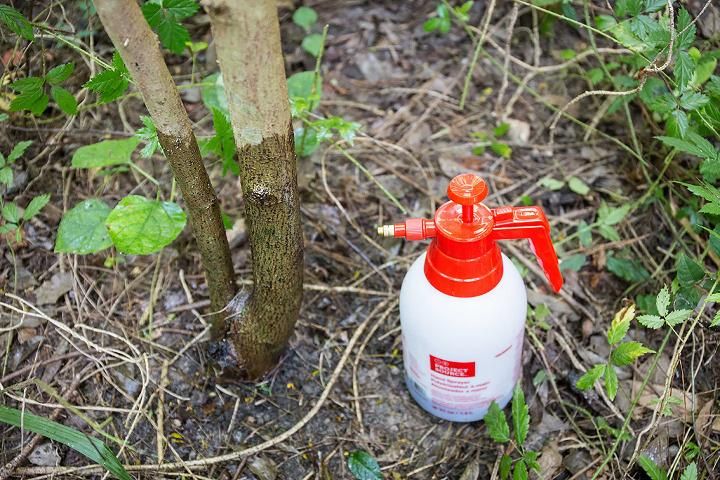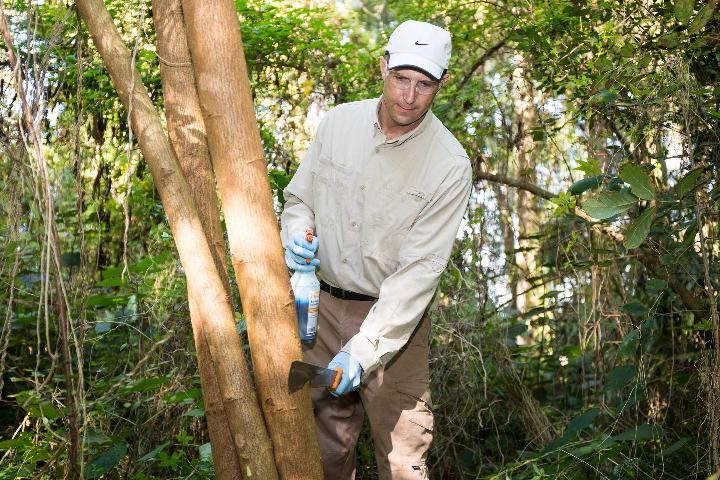Several plant species that are invasive in natural areas of public lands also occur on private property. These may have been planted intentionally, introduced as seeds from other areas, or may have spread across property lines. Invasive plants on private property that thrive within both landscaped and surrounding natural areas can serve as a source of infestation to other natural areas. Therefore, property owners are encouraged to remove invasive plant species from both areas. In certain counties, ordinances may require the plants' removal. Private landowners and homeowners can play an important role in the effort to control invasive plant species and protect natural areas.
Control methods for woody invasive plants that can be used by homeowners are similar to those used in natural areas by professional land managers. However, the scale can be very different, ranging from the removal of a single tree in a small landscaped yard to many trees across several acres. The packaging, availability, and occasionally concentration of active ingredients within herbicide products used by homeowners and professional land managers may also differ. It is important to note that herbicide labels make a clear distinction between ornamental landscaping sites and natural area (non-crop) sites. This distinction must be made, and herbicide should be applied according to the instructions in order to avoid severe nontarget injury to desirable trees and shrubs. This publication discusses methods and herbicides that homeowners can readily use to remove invasive plants from landscapes and surrounding natural areas. Additional information and training can be obtained from your local UF/IFAS Extension office. Always follow the directions on the manufacturer's label for specific herbicides. Check with your local government to determine if a permit is required before removing unwanted trees.
Herbicides
Herbicide products contain an active ingredient, a diluent (to dilute or dissolve the active ingredient), and sometimes other additives which enhance the performance of the herbicide (e.g., surfactants and emulsifiers). The active ingredient may be either water-soluble (diluted in water) or oil-soluble (diluted in oil). Active ingredients contained in the majority of herbicide products used by professional land managers are glyphosate (water-soluble), triclopyr amine (water-soluble), triclopyr ester (water- and oil-soluble), aminopyralid (water-soluble), and imazapyr (water- and oil-soluble) (Table 1). The amount of active ingredient contained in an herbicide product varies and is expressed on the herbicide label as pounds of active ingredient per gallon (gal.) of product or as a percent.
Triclopyr Amine
Triclopyr amine is a growth regulator-type herbicide, which means that it causes abnormal and/or suppressed plant growth that may result in plant death. It is effective against a wide range of woody plant species. Triclopyr amine-containing herbicide products used by commercial applicators usually contain 31.8% (acid) triclopyr and are sold in 2.5 gal. or larger containers only by agricultural supply stores and pesticide distributors. Triclopyr is available for homeowner use in more dilute (0.8%–8.8%) products and smaller containers (8 oz–1.3 gal.) from garden supply stores. While commercial product labels recommend up to full strength for certain applications, diluted or undiluted product that contains 8.8% is usually effective for most landscape applications. Triclopyr amine should not come into contact with nontarget foliage or plant roots of desirable species.
Triclopyr Ester
Like triclopyr amine, triclopyr ester is a growth regulator-type herbicide that is also effective against a wide range of woody plant species. Triclopyr ester-containing herbicide products used by commercial applicators usually contain 43.6% or 9.81% (acid) triclopyr, and they are sold in 2.5 gal. or larger containers. These products are available only from agricultural supply stores and pesticide distributors. The concentrated product (43.6%) can be diluted in water for foliar applications or in oil for basal bark applications. The more dilute product (9.81%) is a "ready-to-use formulation" and is used undiluted for basal bark and cut stump treatments. Triclopyr ester should not come into contact with nontarget foliage or plant roots of desirable species. Triclopyr ester is also volatile and, therefore, can be absorbed by plants as a vapor, which can cause unwanted damage. The potential for vaporization increases at temperatures above 80°F, and vaporization is very likely above 90°F.
Glyphosate
Glyphosate kills plants by interfering with the synthesis of proteins produced only by plants. Glyphosate is also effective against a wide range of woody plant species. Glyphosate-containing products used by commercial applicators contain 30.8%–39.9% glyphosate (acid) and are available in 1 gal. and larger containers from agricultural supply stores and pesticide distributors. Glyphosate-containing products with these same concentrations or more dilute, ready-to-use products are available to homeowners in garden supply stores. Glyphosate is not volatile and has little potential for absorption by plant roots.
Aminopyralid
Aminopyralid is primarily effective on legumes such as lead tree (Leucaena leucocephala), mimosa (Albizia julibrissin), kudzu (Pueraria montana var. lobata), and rosary pea (Abrus precatorius). However, it also works on several other plant families and is very effective on Chinese tallowtree (Sapium sebiferum) when applied as a cut stump treatment. Aminopyralid is not appropriate for use in landscaping, but it is labeled for use in non-crop and natural areas. Aminopyralid-containing herbicide products used by commercial applicators usually contain 21.1% (acid) aminopyralid. They are sold in 1 qt. and 1 gal. or larger containers and are available only from pesticide distributors. This herbicide is soil active, so it should not be allowed to come into contact with nontarget foliage or plant roots of desirable species. Aminopyralid has also caused problems with composting. Any plant material treated with aminopyralid should never be composted, because the herbicide will persist in the finished material and injure or kill most vegetables.
Imazapyr
Imazapyr kills plants by interfering with the synthesis of proteins produced only by the plants. It is one of the most effective herbicides used for woody invasive plant control. However, it is not labeled for use in in home landscapes because it is readily absorbed by plant roots, active at very low concentrations in the soil, and can persist in the soil for more than one year. Many homeowners and property owners have unintentionally injured or killed desirable trees and shrubs by using imazapyr on inappropriate sites.
Methods for Removing Invasive Plants
Hand-Pulling
Newly emerged seedlings of woody plants frequently appear in home landscapes. These often grow from seeds dispersed by nearby trees, birds and other animals, or wind and water. Seedlings can generally be removed by hand-pulling, especially in small areas. However, hand-pulling becomes much more difficult when seedlings appear in high numbers and grow into well-rooted saplings. Tools that aid in hand-pulling saplings, such as the "Extractigator" and the "Uprooter," are available for purchase online.
Stump Grinding
When trees are cut down, the stumps are often ground below the soil surface with a stump grinder. This method removes the stump for aesthetic purposes but adds additional cost to the tree removal. Invasive tree species vary in their ability to sprout after stump grinding, and certain species may regrow from any remaining portions of the stump or lateral roots. If sprouts occur, they can be controlled using one of the herbicide application methods listed below.
Foliar Herbicide Applications
Foliar application refers to applying herbicide to the leaves (foliage) of unwanted plants. Seedling trees and shrubs and herbaceous plants can be controlled by foliar application of triclopyr- (amine or ester) or glyphosate-containing products; however, triclopyr-containing products are more reliable for woody plant control. The herbicide solution will kill most plants that it contacts, so it should be applied only to unwanted plants. Foliar applications are generally made with a hand pump or backpack sprayer. Lightly spray the foliage until wet, but avoid applying an excess of spray solution in order to prevent runoff (Figure 1).

Credit: Lyon Duong, UF/IFAS
Cut Stump Herbicide Application
Stumps of almost all invasive woody plants will sprout after cutting if not treated with an herbicide. Sprouts can be continually cut off as they appear, but herbicide application to the stump will kill it and prevent sprouting. Stumps should be cut as close to the ground and as level as possible (Figure 2) so that applied herbicide does not run off. On large stumps, the herbicide should be applied just inside the bark (Figure 2). This is where the living tissue which will carry the herbicide into the roots is located. For small stumps, it is acceptable to treat the entire stump top. Sawdust should be removed from the stump to prevent herbicide adsorption and reduced effectiveness. Apply the herbicide to the stump as quickly as possible after cutting. A fresh stump is still living and will seal itself very quickly. If delayed treatment following cutting is inevitable, triclopyr ester-containing products should be applied to the stump's bark, exposed roots, and top for more reliable control.

Credit: Lyon Duong, UF/IFAS
Basal Bark Herbicide Application
Many woody plants can be killed without cutting the tree down by applying oil-soluble herbicides to the bark (Figure 3). This method is only recommended for trees or shrubs with stem diameters of 4 inches or less. However, larger trees with very thin bark and stem diameters measuring up to 6 inches may also be controlled. Applying oil-soluble herbicides with basal bark treatment is faster than cutting vegetation down and treating the stumps. It is useful for homeowners who have larger numbers of woody plants to kill in an area where it is acceptable to leave dying and dead vegetation standing. An oil-soluble herbicide, triclopyr ester, must be used for basal bark applications to facilitate movement of the herbicide through waxy substances in the bark. For small jobs, the ready-to-use triclopyr ester formulation (9.81%) is the easiest product to use.

Credit: Lyon Duong, UF/IFAS
Hack-and-Squirt, Frill, or Girdle Herbicide Application
Basal bark application will not be effective on trees with bark that is too thick for herbicides to penetrate. In these cases, some bark must be removed before herbicide application. These are known as hack-and-squirt, frill, and girdle treatments. For hack-and-squirt, a sharp implement, such as a machete or hatchet, is used to make cuts through the bark, and an herbicide is applied directly into these cuts with a squirt bottle (Figure 4). Make cuts around the entire circumference of the tree at a height that is as low to the ground as is comfortable for the applicator. Herbicide labels will specify the required spacing between cuts for effectiveness. For certain species, complete girdling is necessary for control. Melaleuca (Melaleuca quinquenervia) is a good example of a species that requires a complete girdle with herbicide treatment for effective control. For any of these methods, either a water-soluble or oil-soluble herbicide may be used.

Credit: Lyon Duong, UF/IFAS
Licenses and Training
Anyone who performs pest control on Florida lawns and ornamentals as a business, anyone who applies pesticides to their own business property, employees who apply pesticides to their employer's business property, or any government employee who applies pesticides to lawns and ornamental plants of formal plantings adjacent to public buildings must be licensed according to provisions in Chapter 482 of the Florida Statutes. Additional information on pesticide licensing and training can be obtained from UF/IFAS Extension offices or the EDIS website at https://edis.ifas.ufl.edu/entity/topic/pesticide_applicator_certification.
A license is not required to purchase or apply any of the herbicides discussed in this article on your own property (non-business). A yard maintenance person who applies a pesticide to the lawn or ornamental plants of an individual residential property is exempted from licensing and certification requirements if the pesticides are owned and supplied by the individual property owner. However, unlicensed yard maintenance people cannot advertise for or solicit pest control business, and they cannot represent themselves to the public as being engaged in pest control. Unlicensed yard maintenance people cannot supply their own pesticide application equipment, use pesticide application power equipment, or use any equipment other than a handheld container when applying pesticide.
Anyone using an herbicide (or any pesticide) is required by law to follow the "Directions for Use" on the manufacturer's label. Training in pesticide application is recommended for anyone who applies their own pesticides and is provided at UF/IFAS Extension offices in each county (https://sfyl.ifas.ufl.edu/find-your-local-office/). Training manuals for self-study of pesticide application are available through the UF/IFAS Extension Bookstore (352-392-1764 or https://ifasbooks.ufl.edu).
Control of Specific Invasive Plants
On the label, the manufacturer will recommend using the herbicide to control those species for which it has sufficient control data. Herbicide products with the active ingredients triclopyr and glyphosate are effective for controlling many invasive plant species that are not always listed on the labels when applied using the methods described in this publication. It is legal to apply an herbicide to control a plant species that is not listed on the manufacturer's label as long as the herbicide is applied to a site approved by the label. Although the herbicides that are more readily available to homeowners have not been tested on all invasive species in Florida, products with the same active ingredients have been tested and used by professional land managers throughout the state. Although results may vary depending on various factors, triclopyr- and glyphosate-containing products have been found to be effective in Brazilian pepper (Schinus terebinthifolius), carrotwood (Cupaniopsis anacardioides), Chinese privet (Ligustrum sinense), Chinese tallow, and melaleuca control. Methods for controlling invasive plant species can also be found in EDIS publication WG209, Integrated Management of Nonnative Plants in Natural Areas of Florida (https://edis.ifas.ufl.edu/wg209). Additional information specific to these and other invasive plant species can be obtained by visiting the EDIS website (https://edis.ifas.ufl.edu) or calling your local UF/IFAS Extension office.